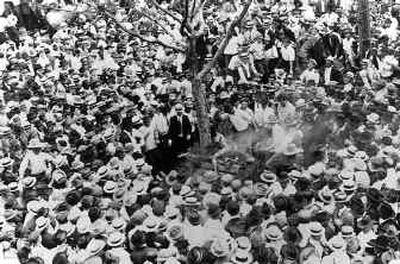Lynching of black teenager in 1916 stirs debate in Waco

WACO, Texas – Nearly a century after a black teenager was stabbed, burned and hanged in front of some 15,000 Waco residents, some black residents are calling for the city to make amends.
The slaying was just one of the 4,700 lynchings in the South from the late 1800s to early 1900s, but it was one of the few photographed in progress, capturing images of a mob dragging 17-year-old Jesse Washington from the courthouse, cutting him with knives and dangling him over a fire.
Newspapers referred to the 1916 killing as the “Waco horror” after the National Association for the Advancement of Colored People’s magazine published an article and the rare pictures, now displayed in the National Civil Rights Museum in Memphis, Tenn.
Two new books have renewed interest in the case and spurred calls for the city to apologize to the black community or erect a historical marker.
“I think it’s appropriate. I think it’s time … because if we don’t address things, we never get healed,” said Michael Babers, a black minister.
City officials did not return calls seeking comment Friday. Three years ago, county commissioners rejected a request to create a plaque to explain a courthouse painting of Waco history that includes a tree with a noose.
Houston author Patricia Bernstein, who wrote “The First Waco Horror: The Lynching of Jesse Washington and the Rise of the NAACP,” said Wednesday that she wanted to help residents start a dialogue about how the city should address the lynching, which happened after Washington was convicted of raping and killing a white woman.
She told a mixed-race audience at a Waco church that there’s a legend in the black community that Waco’s devastating 1953 tornado followed the path where a lynching victim had been dragged.
“Imagine the longtime pain of people who were so unable to do anything about these horrible things themselves, not even to speak out … that this was the only thing they could take refuge in,” said Bernstein, who is white. “Well, (they believed) God finally took retribution on Waco.”
Amber Franklin, 16, said she had never heard about the lynching until she attended the speech.
“I feel like I’ve been robbed, like maybe I should have known about this a long time ago,” said Franklin, who is black.
Waco residents who don’t want to bring up the lynching cite the negative publicity the city has faced since the deadly Branch Davidian standoff in 1993, said Jim Vaughan, president of the Greater Waco Chamber of Commerce. The siege ended with sect leader David Koresh and nearly 80 followers dying as their fortified compound burned to the ground 10 miles outside town.
Vaughan said he has mixed feelings about a historical marker for the lynching but believes talking about the incident is important.
“I think there are some whites and some African Americans that will come closer together,” said Vaughan, who is white and has lived in Waco a year. “I would hope something positive would come from the discussion.”